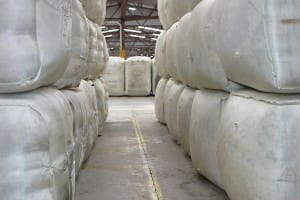 Prices for Australia wool improved again this week, despite a one cent rise in the Australian-US dollar exchange rate and its cost lifting in US dollar terms.
Prices for Australia wool improved again this week, despite a one cent rise in the Australian-US dollar exchange rate and its cost lifting in US dollar terms.
Merino wool prices lifted 15-20c/kg, especially in Fremantle, and crossbred wools also reached new heights.
Growers benefited from increased competition for the smaller quantities of the preferred better spec Merino fleece wools, as some traders bought to meet pre-Christmas shipping commitments.
AWEX EMI lift 8 cents to 1050c/kg
The Australian Wool Exchange quoted the AWEX Eastern Market Indicator as up eight cents to 1050c/kg, with the US$ EMI at 913 cents, up 19 cents and the Australian dollar trading at 86.93 cents, up 1.18 cents.
Brokers passed in just 6.5 percent of the 45,345 bale offering in Sydney, Melbourne and Fremantle.
AWEX senior market analyst Lionel Plunkett said the lift in the market came despite a one-cent rise in the Australian dollar which had benefited from a softer US currency.
“In US terms the EMI was 19 cents higher, more than double the eight-cent lift in local terms.
“Most of the Merino microns closed 15 to 20 cents higher this week after a flat start on Tuesday at a single auction centre – Melbourne,” he said.
“The following day was more upbeat and saw improvements in all three markets.
“Fremantle, which hosted a one-day sale, recorded the largest rises of 15 to 20 cents.”
Melbourne leads the way with 25c lift in 19 micron wool
Mr Plunkett said the eastern markets followed suit on Thursday, although Melbourne led the way higher with a jump of 25 cents in the 19 micron sector.
“The recent trend of strong buyer support for the better spec types continued this week amid low quantities.
“Representing just one-third of the Merino fleece offering, low mid-break (<50) volumes are at a multi-year low,” he said.
But despite strong interest in the fleece sector, Mr Plunkett said Merino skirting prices tracked sideways during the sale.
“Crossbreds found good support, adding 14 cents to the Micron Price Guide.”
28 micron crossbred wool at a three-year peak
Mr Plunkett said prices for 28 Micron Price Guide wool were sitting at the highest level in three years, around 700 cents in the north and south. In March 2011 the 28MPG for the two markets was around 735 cents and Mr Plunkett said a further 35 cent increase from the current level would put the 28MPG’s at a 12-year high.
“It’s happy days for those crossbreds.”
Merino cardings made only minor movements for the sale, he said. Next week the offering is forecast to be just over 50,000 bales, the largest sale in 10 months.
Less better spec wool on offer
Australian Wool Network technical officer Maurice Jolly said there was less better spec wools available and there was a “squeeze” on for shipping among traders.
“Christmas is coming up, with the last sale in Melbourne in the week of December 8, so they want to make sure they get their quotas.”
Mr Jolly said there was not as much crossbred wool being produced in New Zealand due to dairy industry growth.
“The Kiwis have normally got a big heap of it, but because the quantities are down over there it has put a squeeze on crossbred wools everywhere.
“With all the composite breeds and Dohne crossbreds, crossbred wool was varying from 23 to 34 microns – there is a big spread.”
Quality price discount out to 300 cents for 16 and 17 microns
But Mr Jolly said if Merino wools were over 100 millimetres in staple length and sound with a tensile strength of 35-40 Newtons/kilotex, but with more than 60 percent in the mid-break, “the buyers are caning them.”
The price difference between poor style low spec unsound wools with high mid-point breaks and the best style, better spec, sound Merino wools of good staple length was still 200c/kg-plus, Mr Jolly said.
“With your 16 and 17 micron wools it is probably more like 300c/kg and for your 18-23 micron wools it is 200c/kg.”
Mr Jolly said European buyers were paying a premium for better spec wools albeit at a low plane and when buyers were selective the lower spec wools get “a flogging”.
“The Italians won’t use any of that lower spec wool, they only want the good stuff and they are the blokes that are making the money.
“But they are buying good 16s, 17s and 18s (microns), 40-50 Newtons/kilotex stuff, for 1000-1100 greasy.”
Sources: AWEX and AWN

Of course the Italians are making money,buying fine Wool and selling it as Cashmere and Mohair.